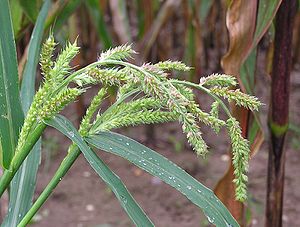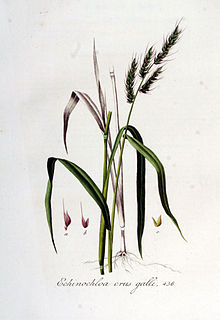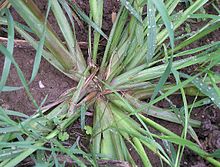Chicken millet
| Chicken millet | ||||||||||||
|---|---|---|---|---|---|---|---|---|---|---|---|---|

Barn millet inflorescence ( Echinochloa crus-galli ) |
||||||||||||
| Systematics | ||||||||||||
|
||||||||||||
| Scientific name | ||||||||||||
| Echinochloa crus-galli | ||||||||||||
| ( L. ) P.Beauv. |
The chicken millet ( Echinochloa crus-galli (L.) P. Beauv .; Syn .: Panicum crus-galli L. ) is a plant species within the sweet grass family (Poaceae). It is widespread in Central Europe in fields and gardens.
description
The chicken millet is an annual herbaceous plant that normally reaches heights of between 30 and 100 cm, under favorable circumstances and in high vegetation of up to 2 m. From an often heavily branched base, several stiff stalks start off more or less horizontally, then ascending more and more steeply. The leaves are divided into leaf sheath and leaf blade. The leaf sheaths are clearly flattened in this area. The leaf blade is 1 to 2 cm wide. A ligula is absent or at most consists of a few tiny hairs.
The flowering period extends from July to September. The inflorescence, which is usually around 10 cm long, consists of a main axis, from which branch off partial inflorescences that are sometimes slightly hanging, pseudo-eared (in reality racemose ). On these the spikelets are again arranged in short cluster-shaped groups, which, however, are usually so close that they are not immediately recognizable. Usually the spikelets are one-sided, so that one side of the pseudo-ear axis is free. The spikelets are oval and short-pointed with a length of 2 to 3 mm. Often these are covered in purple. Like the inflorescence axis, they are short and stiffly haired, often with quite long stiff hairs at the base, which can even protrude above the spikelets. One of the husks bears a short awn that is up to a few centimeters long.
The number of chromosomes is 2n = 54.
ecology
The chicken millet is a summer annual plant and is very sensitive to frost; it dies quickly after the first autumn frosts. It is a C 4 plant of the PEPCK type. Its roots are over a meter deep.
In terms of flower biology, they are wind- flowering of the "long dust thread type".
The fruits are caryopses . The spikelets usually fall off as a whole at maturity; the uppermost glume is prickly and flexible and serves as a Velcro organ for the Velcro spread. In addition, the chicken millet is a wind spreader, as well as a cultural companion due to human spread ( agochory ). The seeds ripen with us only after long, hot summers; they are warmth germs. The fruit ripens from September to October. Since it is a warming germ , the young plants in Central Europe only appear in early summer .
Occurrence
The chicken millet occurs in areas with a temperate and warm climate on both hemispheres, north to southern Canada and Norway. In America and New Zealand she is a neophyte. The species loves warmth in North America and Europe, it needs 160 to 200 days of vegetation and July temperatures of 16 to 25 ° C. Especially as a young plant it needs a lot of moisture, it grows best at 35 to 65 percent soil moisture, but also tolerates water-saturated soils and temporary flooding very well. In rice fields it can withstand overflows of 90 centimeters high for up to 40 days. The plant is soil-vague and indifferent to the lime content in the soil, but needs nitrogen-rich locations.
In Central Europe it is widespread and frequent and grows mainly on moist to wet and very nitrogen-rich soils , for example in gardens or fields with heavy, waterlogged and heavily fertilized soil, also in cesspools, in the mud at roadsides or on the banks of eutrophic or hypertrophic waters. However, it does not depend on such soils and can also grow on sandy, dry soils, for example. The chicken millet thrives in societies of the classes Chenopodietea (weed societies of the root crop fields) or Bidentetea (two-tooth bank meadows).
Agricultural importance
Chicken millet is an important weed in arable farming worldwide , especially in rice crops. The species is counted among the ten most important weed species worldwide. It can reduce the yield in rice fields by up to 50 percent, but losses of around 10 percent are more typical. In contrast to the morphologically and ecologically similar Echinochloa colona , which predominantly prevails in tropical climates, the chicken millet is more dominant in subtropical to warm temperate climates. In North America it is economically important in rice, potatoes, tobacco and maize, where the species not only reduces the yield through competition with the cultivated plants, but also makes mechanical harvesting more difficult.
Harmful millet can be targeted with the herbicidal active ingredient dimethenamid . However, the species is now resistant to numerous herbicides, and multi-resistant strains also occur in North America.
use
The strength of the fruit was an important source of food for hunters and gatherers in China around 10,000 years ago .
The chicken millet is the wild stem form of the Japanese millet Echinochloa esculenta , which was domesticated from it in Japan about 4000 years ago; today it is cultivated on a small scale in Japan, Korea, China and Russia. This species was also introduced as green fodder to the USA and Australia, where it has not been used much so far, but is said to have great potential because of its high yields. The wild stem form of the chicken millet is no longer grown or cultivated anywhere today.
Phylogeny and Systematics
The genus Echinochloa comprises about 50 annual and perennial species, it is taxonomically extremely problematic with numerous synonymous species names because of the polymorphic species that are very similar to each other.
The genetics of this and related species have been clarified over decades by the Japanese researcher Tomosaburo Yabuno. According to the results, Echinochloa crus-galli is a hexaploid allopolyploid species with a chromosome set of 2n = 6x = 54. The six homologous chromosomes come from two different species, four of them from the species Echinochloa oryzoides and two from a previously unknown, diploid species of the genus . The species is thus of hybrid origin, it results from a cross of two species with stabilization of the hybrid through chromosome duplication. According to genetic data, the region of origin is very likely to be East Asia, from here it was later abducted worldwide. Within the genus, the species forms the crus-galli species complex with its parent Echinochloa oryzoides and the Echinochloa esculenta domesticated from barn millet.
There are four varieties :
- Echinochloa crus-galli (L.) P.Beauv. var. crus-galli : Rich in forms, distributed worldwide.
- Echinochloa crus-galli var. Formosensis Ohwi : growing upright. Weeds in wet rice crops.
- Echinochloa crus-galli var. Praticola Ohwi : Lying-ascending, on, relatively dry, roadsides and in settlements.
- Echinochloa crus-galli var. Oryzoides (Ard.) Lindm. (Syn .: Echinochloa oryzoides (Ard.) Fritsch ): weeds in wet rice cultures.
The specific epithet crus-galli comes from the Latin term crus galli ("cock's legs").
Sources and further information
literature
- Dietmar Aichele, Heinz-Werner Schwegler: Our grasses . 7th edition. Franckh'sche Verlagsbuchhandlung, Kosmos-Naturführer, Stuttgart 1984, ISBN 3-440-05284-2 .
- Werner Rothmaler : Excursion flora for the areas of the GDR and the FRG . Volume 2: Vascular Plants, 14th Edition. People and knowledge, Berlin 1988, ISBN 3-06-012539-2
- Otto Schmeil, Jost Fitschen, Werner Rauh: Flora of Germany and its adjacent areas . 84th edition. Quelle & Meyer, Heidelberg 1968.
- Ruprecht Düll , Herfried Kutzelnigg : Pocket dictionary of plants in Germany and neighboring countries. The most common Central European species in portrait . 7th, corrected and enlarged edition. Quelle & Meyer, Wiebelsheim 2011, ISBN 978-3-494-01424-1 . (Section ecology)
Individual evidence
- ↑ a b c Erich Oberdorfer : Plant-sociological excursion flora for Germany and neighboring areas . 8th edition. Verlag Eugen Ulmer, Stuttgart 2001, ISBN 3-8001-3131-5 . Page 265.
- ↑ Rafaël Govaerts (ed.): Echinochloa crus-galli. In: World Checklist of Selected Plant Families (WCSP) - The Board of Trustees of the Royal Botanic Gardens, Kew . Retrieved November 20, 2016.
- ^ MA Maun & CH Barrett (1986): The biology of Canadian weeds 77: Echinochloa crus-galli (L.) Beauv. Canadian Journal of Plant Sciences 66: 739-759.
- ↑ LGHolm, DL Plucknett, JV Pancho, JP Herberger (1977): The World's Worst Weeds: Distribution and Biology. University of Hawaii Press, Honolulu, Hawaii, USA. ISBN 0-8248-0295-0 . Page 32 ff.
- ^ RJ Smith Jr .: Weeds of major economic importance in rice and yield losses due to weed competition. In: International Rice Research Institute (editor): Proceedings of the Conference on Weed Control in Rice, August 31-September 4, 1981. ISBN 978-971-10-4074-1
- ↑ Work diary 2014 of the fruit growing research institute Jork , p. 185
- ↑ Ronald E. Talbert and Nilda R. Burgos (2007): History and Management of Herbicide-Resistant Barnyardgrass (Echinochloa crus-galli) in Arkansas Rice. Weed Technology 21: 324-331.
- ↑ Xiaoyan Yang, Dorian Q. Fuller, Xiujia Huan, Linda Perry, Quan Li, Zhao Li, Jianping Zhang, Zhikun Ma, Yijie Zhuang, Leping Jiang, Yong Ge, Houyuan Lu: Barnyard grasses were processed with rice around 10000 years ago. In: Scientific Reports , Volume 5, Article No. 16251, 2015, doi: 10.1038 / srep16251 .
- ↑ Salej Sood, Rajesh K. Khulbe, Arun K. Gupta, Pawan K. Agrawal, Hari D. Upadhyaya, Jagdish C. Bhatt (2015): Barnyard millet - a potential food and feed crop of future. Plant Breeding 134: 135-147. doi: 10.1111 / pbr.12243
- ↑ T. Yabuno (1983): Biology of Echinochloa species. In: International Rice Research Institute (editor): Proceedings of the Conference on Weed Control in Rice, August 31-September 4, 1981. ISBN 978-971-10-4074-1
- ↑ Hirofumi Yamaguchi, Aya Utano, Kentaro Yasuda, Azusa Yano, Akiko Soejima (2005): A molecular phylogeny of wild and cultivated Echinochloa in East Asia inferred from non ‐ coding region sequences of trnT ‐ L ‐ F .. Weed Biology and Management 5 (4): 210-218. doi: 10.1111 / j.1445-6664.2005.00185.x
- ↑ Hans Zotter : Ancient medicine. The collective medical manuscript Cod. Vindobonensis 93 in Latin and German. Academic printing and Verlagsanstalt, Graz 1980 (= Interpretationes ad codices. Volume 2); 2nd, improved edition, ibid 1986, ISBN 3-201-01310-2 , p. 116 f. ( Noun herbe Galligrus ).
Web links
- Chicken millet. In: FloraWeb.de.
- Chicken millet . In: BiolFlor, the database of biological-ecological characteristics of the flora of Germany.
- Profile and distribution map for Bavaria . In: Botanical Information Hub of Bavaria .
- Echinochloa crus-galli (L.) P. Beauv. In: Info Flora , the national data and information center for Swiss flora . Retrieved September 30, 2015.
- Thomas Meyer: Data sheet with identification key and photos at Flora-de: Flora von Deutschland (old name of the website: Flowers in Swabia )
- Echinochloa crus-galli in the New Crop Resource Online Program .




